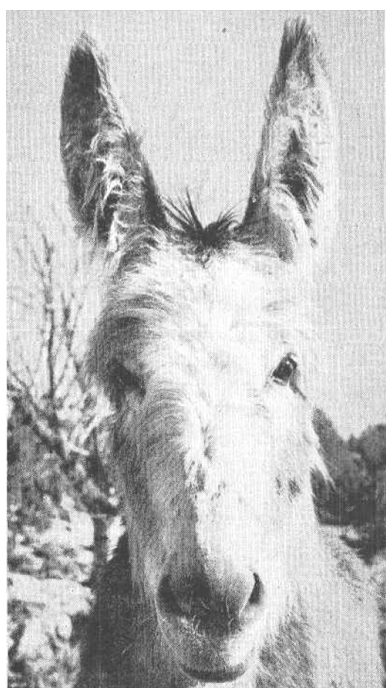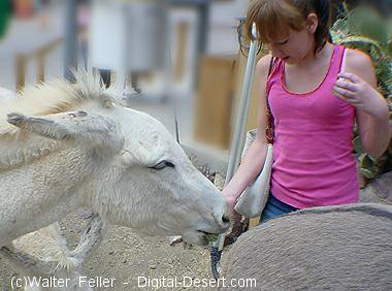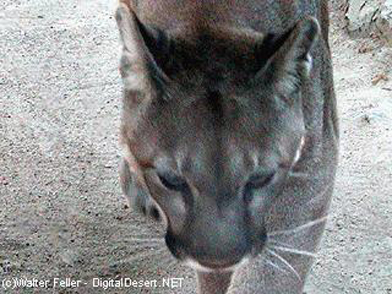Denizens
El Burro
Here is new insight into the character of the burro — an animal which repays measure for measure the treatment given it by man.By EDMUND C. JAEGER, D.Sc.
Curator of Plants
Riverside Municipal Museum
Desert Magazine - February, 1959
The burro often is spoken of as a creature of stupidity and obstinacy, but this is far from the truth. I have owned a number of these animals, ridden and walked behind them over hundreds of miles of trail. The donkey is no fool. It merely resents man's often unreasonable bidding.
If a burro is taken into training early and treated with kindness, it is very responsive and cooperative, almost as much so as a dog. The burro has ideas of its own which should be respected. Mistreated and abused burros are the hard ones to deal with, and they show their disrespect in many clever and often amusing ways.
If loaded too heavily, they will lie down and refuse to move until relieved of their burden. An overloaded burro I once hired on a mountain trip would wait until she got to a sizable stream, then with a deep groan fold her legs, sink down and refuse to move until I lightened her load. I always imagined she was pleased to think she had gotten even with me by thoroughly wetting my provisions.
Donkeys, especially young ones, have good senses of humor and sport. A six-month-old female I had raised from birth used to play every morning for 15 or 20 minutes with a neighbor's cat. The cat thoroughly enjoyed being caressed by the burro's big soft nose, or picked up in her mouth and then dropped to the ground. The burro had fun running alongside the neighbor's barking dog, showing its pleasure by playfully bucking, snorting and swishing its tail from side to side.
This shaggy-faced bright-eyed burro, full of perpetual inquisitiveness, had to learn many lessons by hard experience. The first time she saw a campfire she walked up and poked her nose into it. She thought cholla cactus was good to eat because it was green, and found too late that it was treacherously painful. The prickles went deep into her tender nose, the cactus joint stuck tight. To free herself she butted her nose into her mother's tough-skinned belly where the cactus clung tenaciously. Quickly pulling her nose away, she left the cactus joint clinging to her parent's hide. When this animal grew up she used to get out of pasture by lying flat on her side and working her way under the fence. Quite a clever animal, I'd say.
The burro is an important animal in Mexico, Italy, Spain, Greece and North Africa where for ages it has been the poor-man's chief burdenbearer and enduring friend. The Egyptians domesticated it long before they had horses.
The original wild burro (Equus asinus) from which the donkey we know was derived, came from the wild deserts of Nubia in northeastern Africa where, though rare, it still runs in small herds. It is the fleetest of all animals for long sustained runs over rough country.
The Nubian asses differ from their Asiatic cousins in having much longer ears and narrower hoofs. They are gray in color and have very distinct shoulder and dorsal longitudinal! stripes, markings seen on most domestic donkeys. There are numerous cross-bands on the legs, but these are not as prominent.
The three Asiatic wild ass species more closely resemble the horse. Their ears are smaller, their coats sandy or chestnut in color, and their shrieking bray has little of the volume possessed by the Nubian animals. The largest Asiatic species is the Kiag (Asinus kiang) of the high tablelands of western Tibet and Mongolia. Their thick long furry coats are needed at these cold 14,000-foot altitudes.
The Dziggetai {Asinus hemionus) of Mongolia is somewhat smaller. The Onager (Asinus onager), even paler and smaller, ranges across the Asiatic deserts from Syria to Mongolia; it is the wild ass of the Bible.
Domesticated donkeys in England, Spain and Italy often are very small, weighing only about 350 pounds; in Mexico they average a little larger. This smallness of stature is due to inbreeding and age-long neglect, abuse and lack of proper food.
A healthy well-fed burro, especially a male, may be nearly the size of a small horse. Such animals are capable of carrying without apparent fatigue surprisingly large loads over long distances. In central Mexico I often see them trotting along with loads of hardwood on their backs weighing up to 150 to 200 pounds; and behind on the haunches will be riding a boy or even a man.
Donkeys have a limited vocabulary of sorts and can convey many ideas. I once heard of some men who studied baboons, and learned after two years that they could "talk baboon." I am satisfied that we could learn to "talk burro," or at least understand them. Their brays and whines and guttural grunts have many meaningful inflections. They also express feelings with their tails and ears. A decision suddenly arrived at or a feeling of disgust may be indicated by a rapid single swish of the tail; anger may be shown by a quick drawing back of the ears. I have heard burros cry and beg for food or attention with sounds akin to those of a dog. There are notes which express satisfaction and cries indicative of keen disappointment. No, a burro's bray is not merely something amusing or startling or loud.
Clean Animals
The donkey is a very clean animal both in its eating and drinking habits, and in the care of its coat. Water must be clear and free of odors; its favorite foods are the tender shoots of pungent-tasting herbs and shrubs as well as fresh grasses and flowers. I never saw a burro that would eat canned beans or onions, and if they occasionally chew on paper and dish rags, it is because normal foods are not available. A burro is resourceful, and if pressed far enough will even eat the bitter creosote bush rather than perish.
At the end of a hard day's work on the trail, a burro will immediately start rustling something to eat as soon as out from under the pack, whereas a horse will stand around for a hand-out of grain, or wait to be shown where the green grass is.
Burros are especially fond of sweets, and many a burro owner has found it profitable to start out the day by passing out a few lumps of sugar or a cooky. Prospector Gus Lederer {Desert, Oct. 54) of Corn Springs baked a pancake for each of his 18 burros every morning. It was a gesture of good will that paid big rewards. My burros were always much frightened by rattlesnakes — not only the sight of a reptile, but also the odor of a snake, dead or alive.
Burro flesh is tempting to the mountain lion. Twice I have had to drive off pumas which were ready to spring upon my burros. One evening just at dusk I heard my two animals snorting and blowing very loudly, a sign of extreme apprehension. I rushed forth to see what could be alarming them, and in the faint light I discerned a female lion crawling low to the ground, just about to spring. I gave a great whoop as I sprang into the air, and frightened the big cat off.
It is my belief that some burros have an appreciation of scenery. I've had several which, when turned loose to graze in mountain country, would seek a vantage point and then gaze for many minutes at the broad vista before them. This was especially true at sunset or in the very early morning. Burros in the wild possess a keen and lively eye, and are sleek of form. They are social and gregarious. If they cannot find animals of their kind to be with, they often choose those of other species.
A Sociable Burro
Tristram, author of the monumental The Great Sahara, tells how wild asses of the African desert often consort with the ostrich. One burro I had with me one summer chose a big white bull to wander about with. They were very much attached to one another, and where one was the other was certain to be.
I have become acquainted with several wild burro bands in the Panamint- Death Valley region. Each consists of several males accompanied by 10 to 20 females. They wander about as a merry company grazing closely together, and if any of the females wander far to one side they are promptly guided back into the herd by the males.
At a Waterhole
It is amusing to watch these animals watering at a spring. Mighty are their trumpeting brays, magnificent their show of prowess and skill in meaningful banter.
Prospectors long ago learned that the best way to guard against burros straying from camp was to have only one of the string a female and all the others jacks. The female is tied up at night, and the male burros turned loose to fend for themselves. So attached are they to the jenny, they will never wander out of her sight.
I always feel sorry for donkeys left to stand alone in dreary and often near-grassless enclosures. The burro is a naturally gregarious freedom-loving animal. If people are not prepared to give thoughtful care to such an animal, they should not attempt to keep one. No creature more readily makes response to kindness than a burro. It is as faithful as a dog, and returns attention with equal eagerness.
To the burro I owe many of the happiest and most scientifically fruitful days of my life. It has taught me patience, wise ways and perseverance, as well as love for the simple unhurried life. Senor burro, I salute you as a good neighbor and faithful friend.
END

Desert Magazine
Red Rock Canyon NCA, Las Vegas, Nv.

Oatman, Az.

Puma, mountain lion, cougar